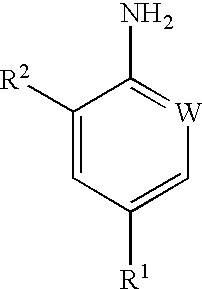Processes for preparing pesticidal intermediates
a technology of pesticidal intermediates and processes, which is applied in the preparation of amino compounds, n-o/n-n bonds, and organic chemistry. it can solve the problems of small amount of unwanted 2-chloro-5-trifluoromethylphenylhydrazine, complex preparation, and high cost of the procedur
- Summary
- Abstract
- Description
- Claims
- Application Information
AI Technical Summary
Benefits of technology
Problems solved by technology
Method used
Image
Examples
example 2
Preparation of 2-Chloro-4-Trifluoromethylaniline
The procedure of Example 1 was repeated but using 2-chloro-4-trifluoromethylphenylhydrazine, to give the title compound in 100% yield.
example 3
Preparation 4-Trifluoromethylaniline
The procedure of Example 1 was repeated but using a catalytic amount of Raney nickel in methanol (8-10 ml per mmole of 4-trifluoromethylphenylhydrazine) under an atmosphere of hydrogen (5 bars) with stirring at 20.degree. C. for 2 hours. The mixture was filtered and evaporated to give the pure title compound in 75% yield (unoptimised).
By proceeding in a similar manner there were also prepared with similar results:
2-chloro-4-trifluoromethylaniline; and
2,6-dichloro4-trifluoromethylaniline.
example 4
Preparation of 4-Trifluoromethylphenylhydrazine
A mixture of 4-chlorobenzotrifluoride (1.08 g), hydrazine hydrate (1.8 g, 6 molar equivalents) and pyridine (5 ml) was heated in an autoclave (purged with argon) for 6 hours at 180.degree. C. The mixture was cooled, the excess hydrazine decanted and the organic phase evaporated in vacuo. The residue was crystallised from petroleum ether to give the title compound in 20% yield. It was shown that 20% of the starting material had been consumed, thus indicating that the reaction had occurred with high selectivity.
PUM
| Property | Measurement | Unit |
|---|---|---|
| Pressure | aaaaa | aaaaa |
| Angle | aaaaa | aaaaa |
| Fraction | aaaaa | aaaaa |
Abstract
Description
Claims
Application Information
 Login to View More
Login to View More - R&D
- Intellectual Property
- Life Sciences
- Materials
- Tech Scout
- Unparalleled Data Quality
- Higher Quality Content
- 60% Fewer Hallucinations
Browse by: Latest US Patents, China's latest patents, Technical Efficacy Thesaurus, Application Domain, Technology Topic, Popular Technical Reports.
© 2025 PatSnap. All rights reserved.Legal|Privacy policy|Modern Slavery Act Transparency Statement|Sitemap|About US| Contact US: help@patsnap.com



